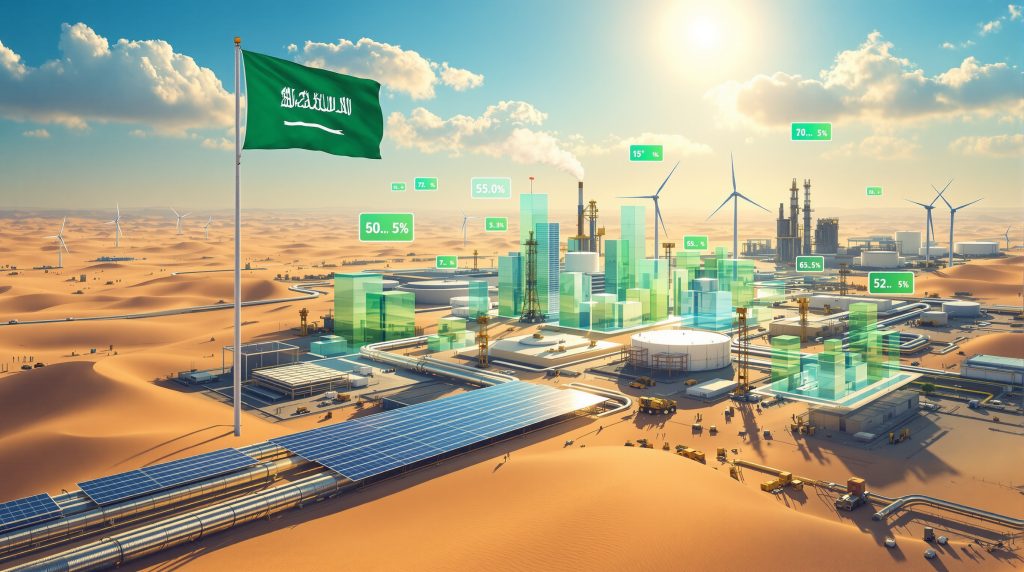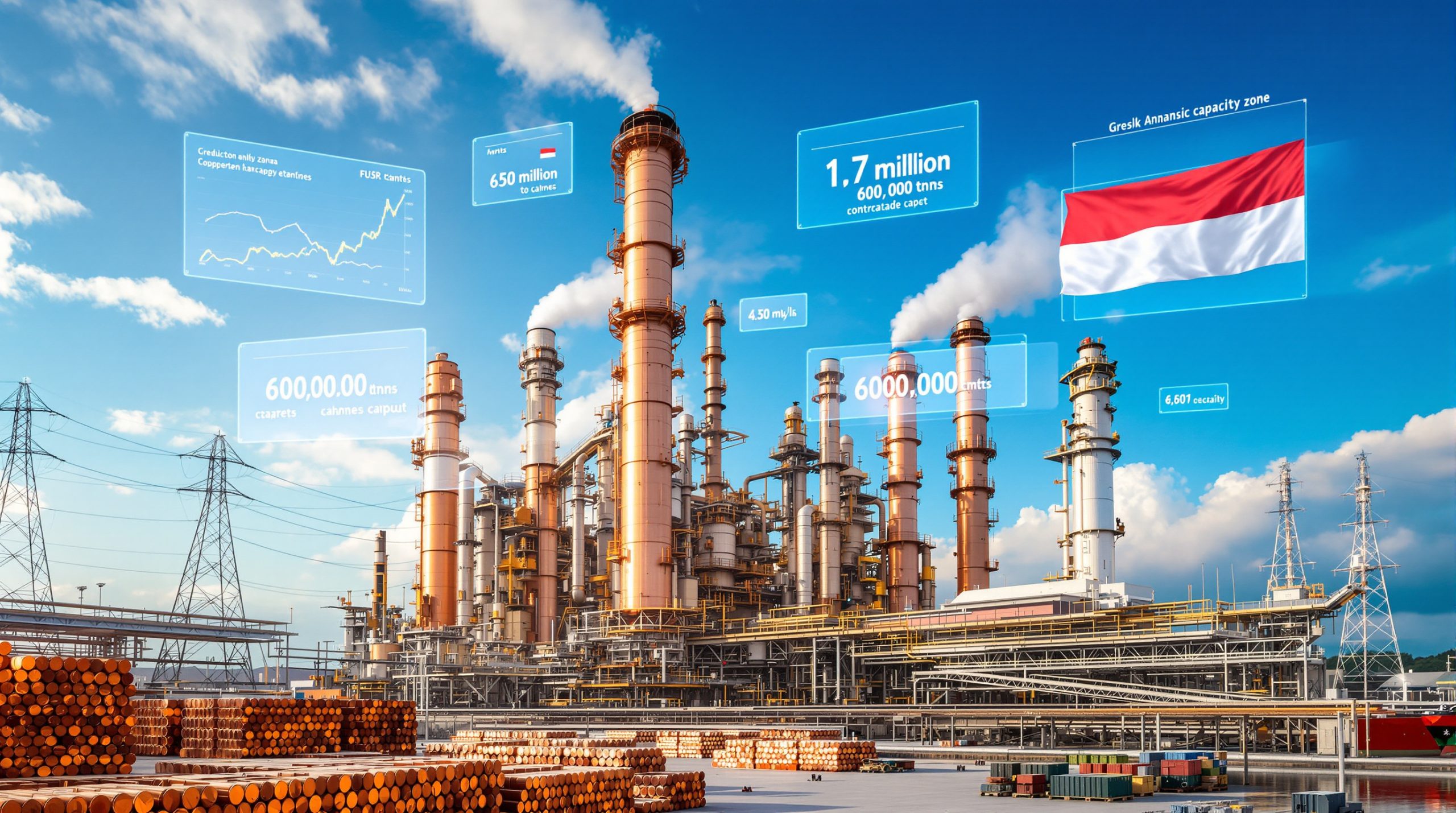Understanding Saudi Arabia's Strategic Energy Revolution
Saudi Arabia's oil-to-gas power transition represents one of the most significant energy sector transformations in the modern era. The Kingdom has systematically begun replacing oil-fired electricity generation with natural gas and renewable sources, achieving measurable progress toward its ambitious 2030 objectives. This strategic pivot extends far beyond environmental considerations, functioning as a calculated economic manoeuvre designed to maximise export revenues while establishing the nation as a diversified energy powerhouse.
Recent performance data reveals the Kingdom has successfully reduced oil consumption for electricity generation by 270,000 barrels per day during mid-2025, demonstrating accelerated momentum toward achieving its Vision 2030 targets. This development signals the beginning of a structural transformation that could reshape global energy markets while positioning Saudi Arabia at the forefront of next-generation energy leadership.
Economic Logic Driving the Power Sector Transformation
The Kingdom's electricity sector has historically consumed substantial volumes of crude oil and fuel oil, particularly during intensive summer cooling periods when air conditioning demand peaks across the region. By systematically redirecting this domestic consumption toward international export markets, Saudi Arabia unlocks extraordinary revenue enhancement opportunities estimated to exceed $150 billion by 2035.
This economic optimisation strategy represents the fundamental driver behind Vision 2030's energy diversification objectives. Each barrel freed from domestic power generation can command full international market pricing, creating direct financial incentives for accelerating transition timelines. The Liquid Fuels Displacement Programme, which targets eliminating approximately 1 million barrels per day of domestic oil consumption by 2030, exemplifies this strategic approach.
Export Market Positioning Strategy
Converting domestic oil consumption into export capacity fundamentally strengthens Saudi Arabia's influence within global energy markets. This enhanced flexibility provides several competitive advantages:
• Price influence capabilities: Greater capacity to impact global oil pricing mechanisms
• Supply disruption responses: Enhanced ability to compensate for international supply interruptions
• Market share expansion: Increased leverage in OPEC+ production quota negotiations
• Revenue diversification: Reduced dependence on domestic fuel subsidisation programmes
The transition also reduces budgetary pressures from subsidised domestic fuel consumption, allowing more efficient allocation of fiscal resources toward economic diversification initiatives. Furthermore, this approach aligns with broader Saudi energy initiatives aimed at regional expansion and global influence.
Natural Gas: The Cornerstone of Saudi Arabia's Energy Mix Evolution
Natural gas serves as the critical bridge technology enabling Saudi Arabia's transition away from oil-fired power generation. The Kingdom's approach leverages both conventional and unconventional gas resources to support this fundamental shift in energy infrastructure.
The Jafurah Gas Field Revolution
The unconventional Jafurah gas field represents the centrepiece of Saudi Arabia's oil-to-gas power transition strategy. This massive development project is expected to increase national gas production capacity by 60% from 2021 baseline levels, with production ramping up during late 2025.
Jafurah Field Impact Projections:
| Metric | Current Baseline | Projected Impact | Timeline |
|---|---|---|---|
| Gas production increase | 2021 levels | +60% | By 2030 |
| Oil displacement potential | Current consumption | 300,000+ b/d | Full development |
| Broader gas expansion impact | Regional projects | Up to 500,000 b/d | End of decade |
The field's development timeline indicates initial production phases beginning in late 2025, with full operational capacity expected by the decade's end. This unconventional resource represents one of the largest gas development projects in the Middle East region.
Power Plant Conversion Programmes
Saudi Electricity Company has initiated comprehensive facility conversion projects targeting major oil-fired power plants across the Kingdom. These conversions offer multiple operational and economic advantages:
• Enhanced thermal efficiency: Gas turbines operate at superior efficiency rates compared to oil-fired units
• Reduced maintenance requirements: Natural gas combustion produces fewer corrosive byproducts
• Improved operational flexibility: Gas-fired plants respond more rapidly to demand fluctuations
• Environmental benefits: Lower emissions profile compared to heavy fuel oil combustion
Major Conversion Projects:
- PP10 Riyadh facility: 3.5 GW capacity plant converting half its turbines to gas in 2025, potentially reducing oil consumption by 40,000-60,000 b/d
- Yanbu 2 plant: 825 MW facility with conversions scheduled through 2030
- Additional facilities: Multiple plants undergoing systematic conversion programmes
Current Power Generation Mix
According to the U.S. Energy Information Administration, Saudi Arabia's current electricity generation portfolio consists of:
• 62% natural gas: Primary baseload generation source
• 38% oil: Traditional fuel oil and crude oil consumption
• Less than 1% renewables: Current renewable energy contribution
The Kingdom's Vision 2030 strategy targets achieving a 50:50 split between gas and renewable sources by the end of the decade, representing a fundamental restructuring of the national energy portfolio. This aligns with the global energy transition strategy that emphasises diversification and sustainability.
Renewable Energy Acceleration Supporting the Transition
Saudi Arabia's renewable energy programme represents one of the most aggressive expansion initiatives globally, targeting 50% of electricity generation from clean sources by 2030. This ambitious deployment schedule supports the overall oil-to-gas power transition by providing additional alternatives to fossil fuel consumption.
Renewable Capacity Growth Trajectory
The Kingdom's renewable energy development has accelerated dramatically:
Capacity Development Timeline:
- 2023 baseline: 3 GW installed renewable capacity
- Mid-2025 achievement: More than 10 GW connected to grid
- Year-end 2025 target: Additional 2.5 GW expected online
- 2030 official target: 130 GW total renewable capacity
- Conservative projections: Nearly 100 GW (IEA estimate)
Even under conservative International Energy Agency projections, Saudi Arabia would account for approximately one-third of all renewable growth in the Middle East and North Africa region, demonstrating the scale and significance of this transformation.
Regional Context and Significance
The broader MENA region faces substantial electricity demand growth, with requirements expected to increase by 50% by 2035, equivalent to 750 TWh of additional generation capacity. Gulf states, driven by air conditioning and desalination requirements, account for the majority of this demand expansion.
Regional energy transformation data indicates the MENA region's oil share in power generation will decline dramatically from 20% in 2023 to just 5% by 2035, replaced primarily by natural gas and renewable sources.
Grid Integration Challenges and Solutions
Balancing intermittent renewable generation with consistent power demand requires sophisticated grid management and control systems. Natural gas serves as the optimal complement to renewable energy sources, providing dispatchable power capacity when solar and wind output experiences fluctuations.
Integration Requirements:
• Advanced forecasting systems for renewable output prediction
• Sophisticated dispatch capabilities coordinating multiple generation sources
• Grid modernisation investments supporting variable generation integration
• Energy storage deployment facilitating renewable energy utilisation
Measurable Results from Saudi Arabia's Power Transition
Data from the Joint Organisations Data Initiative and the International Energy Agency demonstrates tangible progress in the Kingdom's oil-to-gas power transition efforts during 2025.
Oil Consumption Reduction Achievements
Mid-2025 Performance Results:
- 270,000 b/d average reduction: Decline in oil-based power generation fuels (crude oil, fuel oil, gasoil) during June and July 2025
- 100,000 b/d year-on-year decrease: Total oil consumption for power generation during first seven months of 2025
- 1.6% cooling degree days increase: Despite higher cooling demand, oil consumption declined
- Continued demographic growth: Population expansion ongoing throughout transition period
The International Energy Agency characterised these declines as pointing to accelerating improvements in gas availability and renewable deployment, indicating structural rather than temporary changes in the Kingdom's energy consumption patterns. In contrast to regions experiencing oil production decline, Saudi Arabia demonstrates strategic resource reallocation.
Seasonal Demand Management Success
Traditional summer peak periods have historically driven massive oil consumption for air conditioning across Saudi Arabia. The 2025 data demonstrates successful demand management despite challenging conditions:
| Challenge Factor | 2025 Impact | System Response |
|---|---|---|
| Cooling degree days | +1.6% increase | Maintained oil reduction |
| Population growth | Continued expansion | Efficiency gains offset growth |
| Industrial development | Economic diversification | Grid optimisation maintained |
This performance indicates the Kingdom's energy infrastructure improvements are achieving measurable results even under stress conditions that would typically increase fossil fuel consumption.
How Does This Impact Global Energy Markets?
Saudi Arabia's oil-to-gas power transition carries profound implications for international energy markets, potentially reshaping global oil trade patterns and regional energy security considerations.
Export Capacity Enhancement Impact
Freeing 1 million barrels per day of domestic oil consumption by 2030 significantly enhances Saudi Arabia's export flexibility and market influence. This additional export capacity provides multiple strategic advantages:
• Enhanced pricing influence: Greater capacity to impact global oil price mechanisms
• Supply security leadership: Improved ability to respond to international supply disruptions
• Revenue generation expansion: Potential to unlock hundreds of billions in additional export revenue
• Market share strengthening: Increased competitive positioning in global oil trade
Regional Energy Leadership Development
Saudi Arabia's transition model influences neighbouring Gulf states pursuing similar oil-to-gas strategies. The Kingdom's demonstrated success provides a replicable framework for oil-dependent economies seeking diversification without abandoning existing hydrocarbon advantages.
Regional Coordination Benefits:
- Collective negotiating power enhancement in global energy markets
- Technology transfer opportunities across Gulf Cooperation Council nations
- Shared infrastructure development possibilities
- Coordinated approach to energy security challenges
The broader Middle East transformation, with oil's power generation share declining from 20% to 5% by 2035, creates substantial opportunities for coordinated regional energy policy development.
Infrastructure and Timeline Challenges
Despite significant progress, Saudi Arabia's oil-to-gas power transition faces several constraints that could impact achievement timelines and overall effectiveness.
Construction and Development Timelines
Large-scale gas-fired power plant construction requires 3-5 years for completion and commissioning. Many facilities scheduled for conversion will not achieve full operational status until 2027-2028, creating potential gaps in the transition timeline.
Development Timeline Constraints:
• Engineering and design phases: 12-18 months
• Construction and installation: 24-36 months
• Testing and commissioning: 6-12 months
• Full operational capacity: 2027-2028 for many projects
Demand Growth Pressure Factors
Rapid industrial development and population expansion continue driving electricity demand growth across Saudi Arabia. Vision 2030's economic diversification goals include energy-intensive manufacturing sectors that could offset efficiency gains from the power transition.
Demand Growth Drivers:
- Industrial diversification initiatives requiring substantial energy inputs
- Population growth maintaining upward pressure on residential consumption
- Economic development projects increasing commercial and industrial demand
- Tourism and entertainment sector expansion under Vision 2030
These developments reflect broader industry innovation trends that require substantial energy infrastructure investments.
Technical Integration Complexities
Integrating variable renewable generation with existing grid infrastructure demands sophisticated control systems and backup capacity management. Coordination between gas-fired plants and renewable sources requires advanced forecasting and dispatch capabilities that are still under development.
Many energy analysts express scepticism about whether the Kingdom will fully achieve its 2030 renewable energy targets, though the overall direction of progress remains clear and measurable.
What Are the Long-Term Energy Security Implications?
The transition from oil-fired power generation fundamentally enhances Saudi Arabia's energy security profile while supporting broader strategic objectives.
Domestic Energy Independence Enhancement
Reducing reliance on oil for electricity generation creates multiple energy security benefits:
• Portfolio diversification: Multiple energy sources reducing single-fuel dependence
• Price volatility protection: Reduced exposure to global oil price fluctuations
• Strategic reserve optimisation: Oil conservation for high-value export applications
• Infrastructure resilience: Distributed generation sources improving system reliability
Climate Commitments and Carbon Management Integration
The power sector transition supports Saudi Arabia's international climate commitments while maintaining hydrocarbon industry leadership. This balanced approach allows the Kingdom to demonstrate environmental stewardship without abandoning its core economic advantages.
Future carbon capture, utilisation, and storage (CCUS) projects will complement the power sector transition by addressing emissions from continued fossil fuel applications in other sectors. Moreover, the focus on decarbonisation benefits demonstrates how environmental goals can align with economic prosperity.
International Benchmarking and Strategic Positioning
Saudi Arabia's oil-to-gas power transition approach can be evaluated against global energy transformation initiatives and regional peer strategies. Additionally, the Kingdom's approach demonstrates how reduced crude oil burning can free up significant export capacity.
Gulf Cooperation Council Alignment
Other GCC nations pursue similar oil-to-gas transitions, creating regional momentum for coordinated energy diversification. This alignment strengthens collective negotiating power in global energy markets and facilitates technology transfer opportunities.
Regional Transformation Metrics:
- MENA electricity demand growth: 50% increase by 2035 (750 TWh)
- Regional oil power share decline: 20% to 5% between 2023-2035
- Saudi renewable contribution: One-third of regional growth
- Gulf state coordination: Similar transition strategies across multiple nations
Distinguished Strategic Approach
Saudi Arabia's renewable energy targets rival those of developed economies, though the continued prominence of natural gas distinguishes the Kingdom's model from European approaches emphasising complete fossil fuel phase-out.
This strategic differentiation allows Saudi Arabia to maintain energy security while pursuing diversification, creating a potentially more sustainable transition pathway for resource-rich nations.
Investment Opportunities and Economic Development
The oil-to-gas power transition creates substantial investment opportunities across multiple sectors while supporting broader economic diversification objectives.
Infrastructure Development Sectors
The transition generates investment opportunities across various infrastructure categories:
Primary Investment Areas:
• Gas processing and distribution infrastructure development
• Renewable energy project development and financing
• Grid modernisation and smart technology deployment
• Energy storage solutions and integration systems
Technology Transfer and Partnership Potential
International collaborations for advanced gas turbine technology, renewable energy systems, and grid management solutions offer mutual benefits for Saudi Arabia and global technology providers. Furthermore, natural gas power generation offers enhanced versatility compared to traditional oil-fired systems.
Partnership Opportunities:
- Advanced turbine technology transfer agreements
- Renewable energy system integration projects
- Grid management software and control system development
- Energy storage technology deployment initiatives
These partnerships support the Kingdom's technology localisation objectives while providing international companies access to one of the world's largest energy transformation projects.
How Does This Position Saudi Arabia for Future Development?
Saudi Arabia's oil-to-gas power transition represents the foundation for longer-term energy sector evolution extending well beyond the current decade.
Hydrogen Economy Development Potential
The Kingdom's abundant renewable energy resources and existing gas infrastructure position Saudi Arabia for potential leadership in both blue and green hydrogen production. This emerging sector could represent the next phase of energy export diversification.
Hydrogen Development Advantages:
• Existing gas processing infrastructure adaptable for hydrogen production
• Abundant solar and wind resources supporting green hydrogen development
• Strategic geographic position for hydrogen export to European and Asian markets
• Established energy sector expertise transferable to hydrogen technologies
Continued Hydrocarbon Industry Role
Despite the power sector transition, oil and natural gas will maintain central roles in Saudi Arabia's economy through multiple applications:
• Petrochemical feedstock: Industrial applications requiring hydrocarbon inputs
• Transportation fuels: Continued demand for refined petroleum products
• Industrial processes: Manufacturing applications utilising gas and oil derivatives
• Strategic export revenues: High-value international market opportunities
The Kingdom's approach balances immediate transition benefits with long-term hydrocarbon value maximisation, ensuring continued global energy market influence regardless of future technological developments.
Strategic Energy Transition Model for Resource-Rich Nations
Saudi Arabia's systematic oil-to-gas power transition demonstrates how resource-abundant nations can pursue energy diversification while leveraging existing comparative advantages. The Kingdom's methodical approach combines natural gas expansion, renewable energy acceleration, and infrastructure modernisation into a comprehensive transformation strategy.
The measurable success achieved during 2025, including the 270,000 barrel per day reduction in oil consumption for power generation, validates this strategic framework. With the Jafurah gas field ramping up production, major power plant conversions proceeding, and renewable capacity expanding beyond 10 GW, Saudi Arabia's progress toward eliminating oil dependence in electricity generation demonstrates clear momentum.
Success in this transition positions Saudi Arabia as both a traditional energy powerhouse and an emerging leader in next-generation energy technologies. This dual positioning ensures continued global influence and economic prosperity regardless of future energy market evolution, offering a replicable model for similar economies worldwide seeking sustainable energy transformation pathways.
This analysis reflects current industry trends and government policy objectives. Energy market developments and transition timelines may vary based on technological advancement, economic conditions, and policy implementation effectiveness.
Ready to Invest in the Next Major Energy Transformation?
Saudi Arabia's oil-to-gas transition demonstrates how strategic energy shifts can unlock billions in additional export revenue, creating substantial opportunities for savvy investors. Discovery Alert's proprietary Discovery IQ model delivers real-time notifications on significant ASX mineral discoveries, including critical energy transition commodities, empowering subscribers to identify actionable investment opportunities ahead of the broader market.




